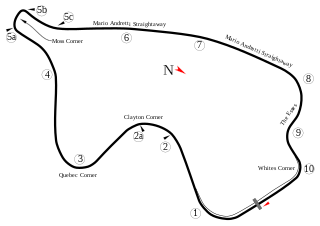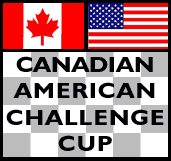Results
| Round | Circuit | Winning driver | Team | Car |
|---|---|---|---|---|
| 1 | Mosport | Frissbee-Chevrolet | ||
| 2 | Summit Point | March-Chevrolet | ||
| 3 | St. Louis | March-BMW | ||
| 4 | Mosport | Frissbee-Chevrolet |
| 1986 Can-Am season | |||
| Previous: | 1985 | Next: | 1987 |
The 1986 Can-Am season was the nineteenth running of the Sports Car Club of Americas prototype series, and the tenth running of the revived series. The dominant manufacturers were Cosworth, BMW, and Volkswagen for the first time with a third-place finish at Summit Point. [1] The dominant chassis were Lola, March, Oscella, Yorkshire, Frissbee-Lola, and Frissbee. After 1986, Can Am would become the Can Am Teams championship, using modified CART March 86Cs. [2] In 1989, the name was again revied with a spec Shelby series. [3] Horst Kroll was declared champion.
The season did, however, introduce a young Paul Tracy, who won the final round at Mosport at the age of seventeen. [4]
| Round | Circuit | Winning driver | Team | Car |
|---|---|---|---|---|
| 1 | Mosport | Frissbee-Chevrolet | ||
| 2 | Summit Point | March-Chevrolet | ||
| 3 | St. Louis | March-BMW | ||
| 4 | Mosport | Frissbee-Chevrolet |
Lola Cars International Ltd. was a British race car engineering company in operation from 1958 to 2012. The company was founded by Eric Broadley in Huntingdon, England, and endured for more than fifty years to become one of the oldest and largest manufacturers of racing cars in the world. Lola Cars started by building small front-engined sports cars, and branched out into Formula Junior cars before diversifying into a wider range of sporting vehicles. Lola was acquired by Martin Birrane in 1998 after the unsuccessful MasterCard Lola attempt at Formula One.

Canadian Tire Motorsport Park is a multi-track motorsport venue located north of Bowmanville, in Ontario, Canada, 40 miles east of Toronto. The facility features a 2.459-mile (3.957 km), 10-turn road course; a 2.9 km advance driver and race driver training facility with a quarter-mile skid pad and a 1.5 km kart track. The name "Mosport" is a portmanteau of Motor Sport, came from the enterprise formed to build the track; it is pronounced as the two words actually sound, "Mo-Sport".

Jim Hall is a retired American racing driver, race car constructor, and team owner. While he is best known as a car constructor, he was one of the greatest American racing drivers of his generation, capturing consecutive United States Road Racing Championships, two Road America 500s, two Watkins Glen Grands Prix for sports cars, the 1965 Canadian Grand Prix for sports cars, the 1965 Pacific Northwest Grand Prix, and scoring a massive upset at the 1965 12 Hours of Sebring over a contingent of factory-backed Ford GTs, Shelby Daytona Coupes and Ferrari entries. If anything Hall's accomplishments behind the wheel have been overshadowed by his pivotal contributions to race car design through his series of Chaparral sports racing and Indy cars. Hall's cars won in every series in which they competed: USRRC, Can-Am, Trans-Am, Formula 5000, World Sportscar Championship, Autoweek Championship, Canadian Sports Car Championship, and the Indianapolis 500.

Mark Neary Donohue Jr., nicknamed "Captain Nice," and later "Dark Monohue," was an American racecar driver known for his ability to set up his own race car as well as driving it to victories.

The Canadian-American Challenge Cup, or Can-Am, was an SCCA/CASC sports car racing series from 1966 to 1987.

Formula 5000 was an open wheel, single seater auto-racing formula that ran in different series in various regions around the world from 1968 to 1982. It was originally intended as a low-cost series aimed at open-wheel racing cars that no longer fit into any particular formula. The '5000' denomination comes from the maximum 5.0 litre engine capacity allowed in the cars, although many cars ran with smaller engines. Manufacturers included McLaren, Eagle, March, Lola, Lotus, Elfin, Matich and Chevron.

The MG-Lola EX257 is a Le Mans Prototype built by Lola for the MG car company for their attempt to compete again at the 24 Hours of Le Mans in 2001. The car has had many years of mixed success since its introduction, even in privateer hands.
Graeme Lawrence is a former race car driver from New Zealand. He started serious motor racing in the National 1.5 litre series winning the series decisively in 1968 ahead of David Oxton and Ken Smith. Lawrence then ran half a European F2 series in an uncompetitive semi works F2 McLaren, he found the racing harder than expected and was shaken, by his experience racing in Germany at the Hockenheim race in the rain, were Jim Clark was killed. McLaren allowed Lawrence to build up another F2 chassis in his works and was 2nd in the NZ Gold Star series in the car, and first NZ driver home in the Tasman races at Pukekohe and Levin.
Michael Roe is a former racing driver from Naas, Ireland.
John Morton is an American racing driver from Waukegan, Illinois. After his father took him to a race at Road America in 1957, Morton became an avid racing fan. He went on to race jalopies in South Carolina before he dropped out of Clemson University to attend Carroll Shelby's racing school at Riverside Raceway in California. Taking a menial job working in Carroll Shelby's race shop, Morton saved his money to purchase his first race car, a Lotus Super 7 which he raced in SCCA amateur races in 1963.
The 1977 Can Am season was the tenth running of the Sports Car Club of America's prototype-based series. Despite the revived name, however, the new series was entirely unrelated to the previous series which had folded in 1974. This series used Formula 5000 Lola T332s with fenders added. Patrick Tambay was declared champion, winning six of the nine races that year for Carl Haas. While Lola chassis dominated the series, a Chevrolet powered Schkee DB1 driven by Tom Klausler won the first race at Mont Tremblant. Formula One driver Gilles Villeneuve came in third at Road America in a Wolf. While Chevrolet was not the only engine supplier, they swept the entire season. This season also marked a resurgence of interest in SCCA events, with Can Am accompanying F5000 and the Trans Am Series seeing a mild resurgence in the eighties.
The 1981 Can Am series season was the fourteenth running of the Sports Car Club of America's prototype-based series, and the fifth running of the revived series. Geoff Brabham was declared champion, despite only winning two races. Chevrolet again dominated the season. The dominant chassis manufacturers were March, Lola, Holbert, Frissbee, and VDS. IndyCar drivers Al Unser and Bobby Rahal also podiumed at Road America and Mosport, respectively.
The 1982 Can Am Series season was the fifteenth running of the Sports Car Club of America's prototype series, and the sixth running of the revived series. 1982 brought new competition for Chevrolet in the form of Hart and Cosworth. Hart would podium in three races while Cosworth would podium in two. The most dominant chassis were Frissbee, Marguey, March, VDS-001, and Ensign. Al Unser, Jr. would win at Road Atlanta, Laguna Seca, and Mosport twice, with a podium at Mid Ohio, at Riverside, and at Caesar's Palacae. Unser would be declared champion.
The 1983 Can Am season was the sixteenth running of the Sports Car Club of America's prototype series and the seventh of the revived series. 1983 marked the second year of Chevrolet having major competition, with Cosworth taking second at Mosport, first at Lime Rock, second at Trois-Rivières, first at the second race at Mosport, and second at Sears Point. Hart would take third at Lime Rock and third at Trois-Rivières. Porsche would get its first podiums this season, with a win at Road America and third at the second race at Mosport. The dominant chassis were Frissbee, Ensign, Lola, VDS, Scandia, and Ralt. Jacques Villeneuve, Sr. was declared champion, with podiums in almost every race. He would, however, become the final major racecar driver to win a Can Am championship.
The 1984 Can Am season was the seventeenth running of the Sports Car Club of America's prototype series, and the eighth running of the revived series. 1984 would mark a major downturn in the series, as Juan Manuel Fangio II would become the last major driver to podium in a Can Am Series race, finishing third at Dallas. The dominant manufacturers were Chevrolet, Hart, BMW for the first time with a third-place finish at Brainerd, Cosworth, Lola, Ralt, and March. Dominant chassis were VDS, March, Frissbee-Lola, Ralt, and Williams with their first podium with a third-place finish at Lime Rock. Michael Roe was declared champion, with seven wins. The final race at Green Valley would feature the final truly notable driver in series history, John Andretti.
The 1985 Can Am season was the eighteenth and penultimate running of the Sports Car Club of America's prototype series and the ninth running of the revived series. For the first time in series history, no major drivers would compete in the series. The dominant manufacturers were Chevrolet, BMW, and Hart. The dominant chassis were Frissbee-Lola, March, Lola, Frissbee, Osella, and Ralt. Rick Miaskiewicz was declared champion, with 81 points and three wins.

The Mobil 1 SportsCar Grand Prix is an annual IMSA WeatherTech SportsCar Championship race held every July or August at Canadian Tire Motorsport Park in Bowmanville, Ontario, Canada. It was part of the every American Le Mans Series season from 1999 to 2013. Since 1998, the race is a three-hour race, although under IMSA rules, a "three hour" race is 2 hours 45 minutes, in order to squeeze the race into a television-friendly package. Previous editions of the Grand Prix also belonged to the World Sportscar Championship and the IMSA GT Championship.

The Spyder NF-10 was an American sports prototype racing car built for the Can-Am series in 1978. It was based on a Lola T333CS, and was developed into the Spyder NF-11 in 1979. Two NF-10s were built in 1978, whilst four NF-11s were built in 1979, two of which were originally NF-10s. Both the NF-10 and NF-11 featured a 5-litre Chevrolet V8 engine.
The Frissbee KR3 was an American sports prototype racing car, built by Frissbee in 1984 for the Can-Am series. Originally built by Lola Cars as a Lola T330, it featured a 5-litre Chevrolet V8 engine, and was used by Horst Kroll Racing between 1984 and 1987. Horst Kroll used the car to win both the Can-Am and Canadian American Thundercars Championship in 1986.
Anthony Gordon Dean was a British racing driver from England who competed in sports car racing, touring car racing, the Can-Am series and various single seat formulae, including non-championship Formula One, in the 1960s, 1970s, and 1980s. He is known for winning a round of the Can-Am championship in 1970 as a privateer entrant.